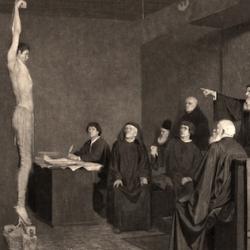The November 21 TLS has a review of a biography of Nicolaus Steno (1638-86), a Danish physician, theologian, and convert to Roman Catholicism who was beatified in 1988. The reviewer gives this account of Steno’s contribution to medicine: “Between 1663 and 1665, he discovered the cheek salivary duct, identified female ‘testicles’ as ovaries, developed an accurate model of muscular contraction, settled the nature of the heart (summed up on his aphorism ‘the heart is a muscle’) and even made the first trule scientific description of the anatomy of the human brain.” In geology, he was the “first to demonstrate scientifically how, in a series of sedimentary layers, the upper layers are more recent than the lower . . . Steno’s second key discovery [in geology] was his proposal that the mysterious glossopetrae ?E’tongue stones’ ?Efound in many rocks, were in fact the teeth of dead sharks. By extension, other apparently organic objects found in rocks, such a seashells, were also the trace of living organisms.” He appealed to the waters of Genesis 1:2 and the flood to explain how aquatic life could be found on the top of mountains. His discoveries also raised questions about the possibility of extinction, which, according to the review, was considered impossible by most theology of the time.
The same review deals with a couple of recent books on James Hutton (1726-97), a Scottish farmer and physician who first argued for an old earth (Steno accepted biblical chronology).















